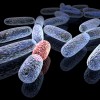This 7-page fact sheet is one in a series of fact sheets discussing common foodborne pathogens of interest to food handlers, processors, and retailers. It covers the characteristics of, and symptoms caused by, the bacterium E. coli (particularly the “big six” strains), and also details how to minimize the risk of spreading or contracting an E. coli infection. Written by Bruna Bertoldi, Susanna Richardson, Renee Goodrich-Schneider, Ploy Kurdmongkoltham, and Keith R. Schneider and published by the UF/IFAS Department of Food Science and Human Nutrition, January 2018.
http://edis.ifas.ufl.edu/fs233
Tag: Susanna Richardson
Preventing Foodborne Illness: Cyclospora cayetanensis
 Cyclospora cayetanensis is a microscopic, spore-forming, intestinal protozoan parasite and a known cause of the gastrointestinal infection cyclosporiasis, often referred to as “traveler’s diarrhea” for its prevalence among visitors to regions where the species is endemic. These organisms have a protective covering that makes them resistant to disinfectants and that gives Cyclospora the ability to survive outside of hosts for extended periods. The incidence of cyclosporiasis has been increasing worldwide, with several documented cases in the United States and Canada. This 4-page fact sheet was written by Keith R. Schneider, Rachael Silverberg, Susie Richardson, and Renée Goodrich Schneider, and published by the UF Department of Food Science and Human Nutrition, March 2015. (Photo: CDC/DPDx – Melanie Moser)
Cyclospora cayetanensis is a microscopic, spore-forming, intestinal protozoan parasite and a known cause of the gastrointestinal infection cyclosporiasis, often referred to as “traveler’s diarrhea” for its prevalence among visitors to regions where the species is endemic. These organisms have a protective covering that makes them resistant to disinfectants and that gives Cyclospora the ability to survive outside of hosts for extended periods. The incidence of cyclosporiasis has been increasing worldwide, with several documented cases in the United States and Canada. This 4-page fact sheet was written by Keith R. Schneider, Rachael Silverberg, Susie Richardson, and Renée Goodrich Schneider, and published by the UF Department of Food Science and Human Nutrition, March 2015. (Photo: CDC/DPDx – Melanie Moser)
http://edis.ifas.ufl.edu/fs130
Genetically Modified Food
 A food is considered genetically modified when its genetic makeup is altered in some way as a result of the use of recombinant DNA biotechnological procedures. These changes result in the expression of attributes not found in the original. Examples include delayed-ripening tomatoes and pest-resistant or herbicide-tolerant crops. Genetic modification can be used to improve crop yields, reduce insecticide use, or increase the nutritional value of foods. This 5-page fact sheet answers questions consumers might have about genetically modified food. Written by Keith R. Schneider, Renée Goodrich Schneider, and Susanna Richardson, and published by the UF Department of Food Science and Human Nutrition, November 2014. (Photo: iStock/Thinkstock.com)
A food is considered genetically modified when its genetic makeup is altered in some way as a result of the use of recombinant DNA biotechnological procedures. These changes result in the expression of attributes not found in the original. Examples include delayed-ripening tomatoes and pest-resistant or herbicide-tolerant crops. Genetic modification can be used to improve crop yields, reduce insecticide use, or increase the nutritional value of foods. This 5-page fact sheet answers questions consumers might have about genetically modified food. Written by Keith R. Schneider, Renée Goodrich Schneider, and Susanna Richardson, and published by the UF Department of Food Science and Human Nutrition, November 2014. (Photo: iStock/Thinkstock.com)
http://edis.ifas.ufl.edu/fs084
Dealing with Food Allergies
 A food allergy is an immune system reaction that happens after a person consumes what is normally considered a safe food. Food allergies occur more often in children than in adults: 4%–8% of those aged 4 or under and about 2% of adults are affected. Allergic reactions from food have led to over 20,000 emergency room visits per year. Annually, between 150 and 200 fatalities associated with food allergic reactions occur in the United States. This 4-page fact sheet was written by Keith R. Schneider, Renée Goodrich Schneider, Soohyoun Ahn, and Susie Richardson, and published by the UF Department of Food Science and Human Nutrition, January 2014.
A food allergy is an immune system reaction that happens after a person consumes what is normally considered a safe food. Food allergies occur more often in children than in adults: 4%–8% of those aged 4 or under and about 2% of adults are affected. Allergic reactions from food have led to over 20,000 emergency room visits per year. Annually, between 150 and 200 fatalities associated with food allergic reactions occur in the United States. This 4-page fact sheet was written by Keith R. Schneider, Renée Goodrich Schneider, Soohyoun Ahn, and Susie Richardson, and published by the UF Department of Food Science and Human Nutrition, January 2014.
http://edis.ifas.ufl.edu/fs123
Preventing Foodborne Illness Associated with Clostridium perfringens
 This is one in a series of fact sheets discussing common foodborne pathogens of interest to food handlers, processors, and retailers. This 5-page fact sheet was written by Keith R. Schneider, Renée Goodrich-Schneider, Michael A. Hubbard, and Susanna Richardson, and published by the UF Department of Food Science and Human Nutrition, January 2014.
This is one in a series of fact sheets discussing common foodborne pathogens of interest to food handlers, processors, and retailers. This 5-page fact sheet was written by Keith R. Schneider, Renée Goodrich-Schneider, Michael A. Hubbard, and Susanna Richardson, and published by the UF Department of Food Science and Human Nutrition, January 2014.
http://edis.ifas.ufl.edu/fs101
Preventing Foodborne Illness: E. coli “The Big Six”
 Escherichia coli is a bacterium usually found in the digestive system of healthy humans and animals and transmitted through fecal contamination. There are hundreds of known E. coli strains, with E. coli O157:H7 being the most widely recognized because of the severe illness it causes. In addition to E. coli O157:H7, the U.S. Food and Drug Administration has identified six serogroups (or “strains”), known as the “big six,” which includes E. coli O26, O45, O103, O111, O121, and O145. These are the most commonly seen types of E. coli found in food in the United States that are not O157:H7, and they cause approximately 37,000 cases per year in the United States. This 5-page fact sheet was written by Susanna Richardson, Renée Goodrich Schneider, and Keith R. Schneider, and published by the UF Department of Food Science and Human Nutrition, October 2013.
Escherichia coli is a bacterium usually found in the digestive system of healthy humans and animals and transmitted through fecal contamination. There are hundreds of known E. coli strains, with E. coli O157:H7 being the most widely recognized because of the severe illness it causes. In addition to E. coli O157:H7, the U.S. Food and Drug Administration has identified six serogroups (or “strains”), known as the “big six,” which includes E. coli O26, O45, O103, O111, O121, and O145. These are the most commonly seen types of E. coli found in food in the United States that are not O157:H7, and they cause approximately 37,000 cases per year in the United States. This 5-page fact sheet was written by Susanna Richardson, Renée Goodrich Schneider, and Keith R. Schneider, and published by the UF Department of Food Science and Human Nutrition, October 2013.
http://edis.ifas.ufl.edu/fs233
The Food Safety Modernization Act and the FDA Facility Registration Program
 The Food Safety Modernization Act that President Obama signed into law January 4, 2011 represents the most sweeping update to food safety regulation since the Federal Food, Drug, and Cosmetic Act of 1938. As part of FSMA, registration is required of facilities that manufacture, process, pack or hold food for human or animal consumption. This 3-page fact sheet was written by Susanna Richardson, Renée Goodrich Schneider, Mark A. Ritenour, Michelle D. Danyluk, and Keith R. Schneider, and published by the UF Department of Food Science and Human Nutrition, July 2013.
The Food Safety Modernization Act that President Obama signed into law January 4, 2011 represents the most sweeping update to food safety regulation since the Federal Food, Drug, and Cosmetic Act of 1938. As part of FSMA, registration is required of facilities that manufacture, process, pack or hold food for human or animal consumption. This 3-page fact sheet was written by Susanna Richardson, Renée Goodrich Schneider, Mark A. Ritenour, Michelle D. Danyluk, and Keith R. Schneider, and published by the UF Department of Food Science and Human Nutrition, July 2013.
http://edis.ifas.ufl.edu/fs231
Preventing Foodborne Illness: Salmonellosis (FSHN0214/FS096)
 In 2007, there were over 1 million cases and some 400 deaths associated with Salmonella-contaminated food. In 2004, it was estimated that the total economic burden caused by Salmonella infection in the United States was $1.6–$5.3 billion. Food handlers, processors, and retailers can minimize the risk of salmonellosis by using good food handling practices. This 6-page fact sheet was written by Keith R. Schneider, Renée Goodrich Schneider, Michael A. Hubbard, and Susanna Richardson, and published by the UF Department of Food Science and Human Nutrition, March 2013.
In 2007, there were over 1 million cases and some 400 deaths associated with Salmonella-contaminated food. In 2004, it was estimated that the total economic burden caused by Salmonella infection in the United States was $1.6–$5.3 billion. Food handlers, processors, and retailers can minimize the risk of salmonellosis by using good food handling practices. This 6-page fact sheet was written by Keith R. Schneider, Renée Goodrich Schneider, Michael A. Hubbard, and Susanna Richardson, and published by the UF Department of Food Science and Human Nutrition, March 2013.
http://edis.ifas.ufl.edu/fs096
Preventing Foodborne Illness: Listeriosis (FSHN036/FS102)
 Listeriosis is one of several foodborne diseases that are often reported in the scientific and popular press. In the United States, it affects about 1,600 people every year, with about 270 of those cases resulting in death. It expresses itself in the affected person by means of septicemia, meningitis, and/or encephalitis. Pregnant women who have intrauterine or cervical infections caused by L. monocytogenes in their second or third trimesters may spontaneously abort the fetus or produce a stillbirth. Influenza-type symptoms, which may include continuous fever, usually precede the aforementioned disorders. This 4-page fact sheet was written by Keith R. Schneider, Renée Goodrich-Schneider, Michael A. Hubbard, and Susanna Richardson, and published by the UF Department of Food Science and Human Nutrition, March 2013.
Listeriosis is one of several foodborne diseases that are often reported in the scientific and popular press. In the United States, it affects about 1,600 people every year, with about 270 of those cases resulting in death. It expresses itself in the affected person by means of septicemia, meningitis, and/or encephalitis. Pregnant women who have intrauterine or cervical infections caused by L. monocytogenes in their second or third trimesters may spontaneously abort the fetus or produce a stillbirth. Influenza-type symptoms, which may include continuous fever, usually precede the aforementioned disorders. This 4-page fact sheet was written by Keith R. Schneider, Renée Goodrich-Schneider, Michael A. Hubbard, and Susanna Richardson, and published by the UF Department of Food Science and Human Nutrition, March 2013.
http://edis.ifas.ufl.edu/fs102
